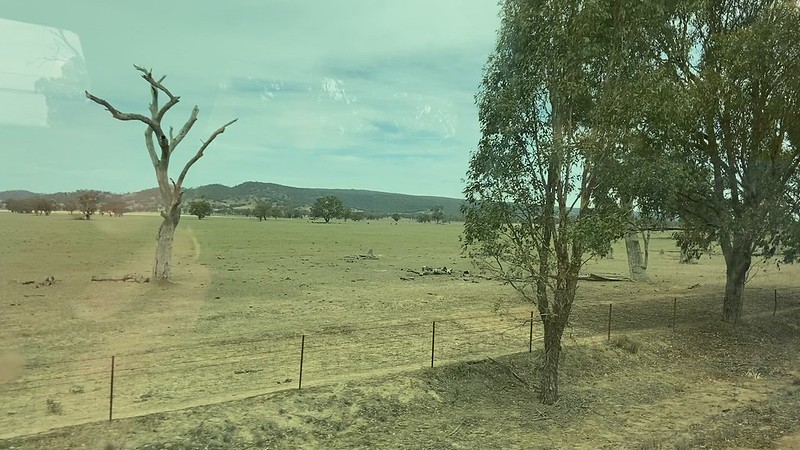
[AUTHOR'S NOTE: Realizing I have neither the time nor the energy to write full posts about my two-week trip to Australia, especially when I have already written fairly extensively in my email photo digests / travelogues, I decided the smartest and most efficient move would be to post the content of those five emails here, backdated. The following was posted on Tuesday, March 10 PST, but was originally sent to my email list midafternoon Wednesday, March 4, local time in Melbourne, where we were when I sent it.]
Monday, March 2, 2020
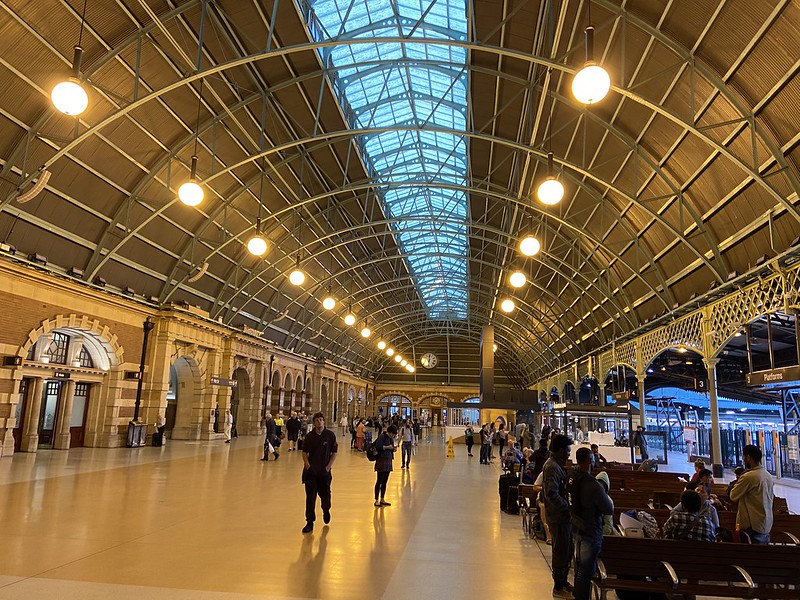
Central Station in Sydney, which we took the transit train to from the airport when we arrived, as it was only about four blocks from our hotel; it was also the station we left out of to head to Melbourne five days later. It's very much a "hub" station, sort of like Sydney's version of New York's Grand Central—transit of all forms converge here: light tail; local transit trains; regional transit trains. I didn't even realize there was this massive upper level when we first arrived, as this is where you go to take trains to places outside Greater Sydney—like, for example, Melbourne. It's a roughly
550-mile, 11-hour trip, typically, which is about 50 miles longer than the distance from Seattle to Boise, Idaho. But, it includes 18 stops along the way.

We passed a fair number of sheep along the way. Shobhit kept pointing them out, saying Australia "makes the best wool in the world." More accurately, they produce the most wool—25% of it, in fact.
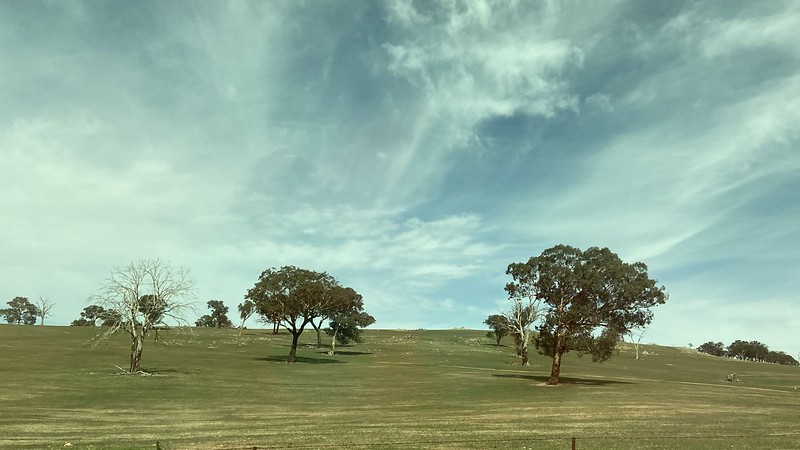
To be honest, I had really hoped for more diversity of scenery than there actually was between Sydney and Melbourne. But, they really aren't quite as far away from each other as I thought they were—although they can still have very, very different weather: it had been very warm all five days in Sydney, but the evening we arrived in Melbourne it was barely 60°F and after dark, so I had to bust out my jacket for the first time on the trip. Anyway, this is my favorite of the shots I got of the scenery from the train. Sometimes there were a lot more trees than this, bus basically most of the way it looked like this.
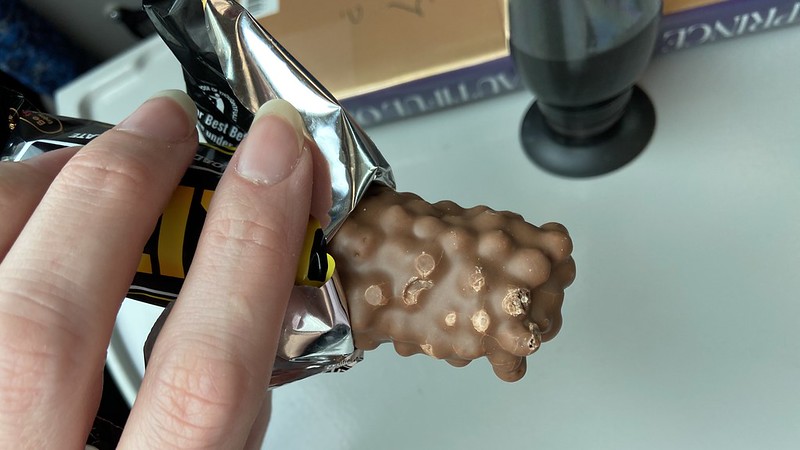
I did have my first Australian candy bar on the train though! This is called a
Chokito bar, made by Nestle—who seems to make a lot of international candy not available in the United States, what's that about? Oh wait, I guess Nestlé is actually a Swiss company. How did I not know that? According to Wiikipedia, they only manufacture this bar in Australia, Switzerland and Brazil.

Is this what passes for mountains in Australia?
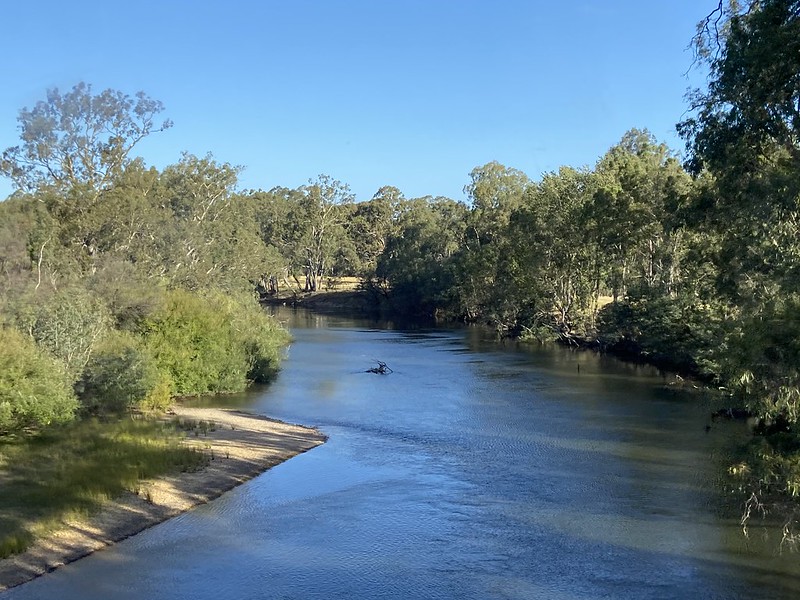
When things are running as they are supposed to, the train ride from Sydney to Melbourne is about eleven hours. But, after about seven hours, once we reached a small city called Albury (population 49,000) near the Victoria state line and about 200 miles inland from the coast, we had to switch to road coaches, and ride a bus the rest of the way through the state of Victoria. There had been a
fatal train derailment, killing two, outside Melbourne on the evening of Thursday, February 20—only five days before we left for Australia. We had not heard the news while still in Seattle, and my Uncle David who lives in Adelaide emailed us to make sure we knew about it. Road coaches temporarily replaced the trains for the entire distance between Sydney and Melbourne, and for a while there we were afraid our original plan to travel between the two cities by rail would not pan out and we would be stuck on a bus the whole way.
But! Fortune tends to favor Matthew and Shobhit's travels, and much to our relief, service resumed on trains out of Central Station to the rest of the state of New South Wales as of two days before we were set to leave Sydney. On the other hand, although I had only seen online that "service was resuming," we did not learn until we were actually several hours into our train ride that the road coaches were still running between Albury and Melbourne, and we would still have to switch there. Oh well; it basically split the difference, and at least seven hours of our trip still got to be on a train where we could get up and walk around a bit, and we did not have to take a bus the entire way.
The above photo was one of the few I took from the bus. We overheard the bus driver talking to another passenger, saying the entire trains would soon be replaced by road coaches again for three weeks as they repair the faulty signals that were the reason for the derailment in the first place. A train conductor had thought he could be going 110 km/hr in a 50 km/hr zone. I don't know how accurate this bus driver's details were, though; the incident has received fairly extensive media coverage and I cannot find any articles specifically corroborating the details he shared. Either way, Shobhit and I felt like we lucked out, as four hours on a bus is a hell of a lot better than twelve.
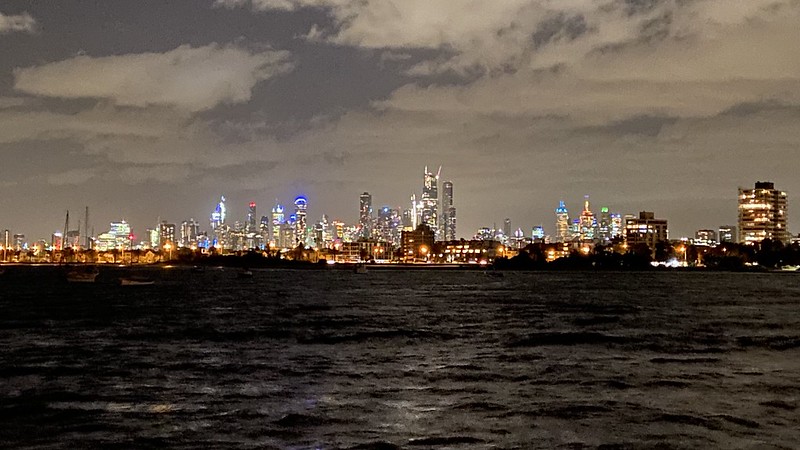
Once we reached Southern Cross Station in Melbourne, we had a fairly easy tram ride to the St. Kilda neighborhood where our hotel was at, albeit after a bit of confusion trying to figure out how to get the transit card we needed to ride the trains. We had deliberately booked a place near the beach, and so we walked over there so I could get several photos of the Melbourne skyline at night from there.
Tuesday, March 3, 2020
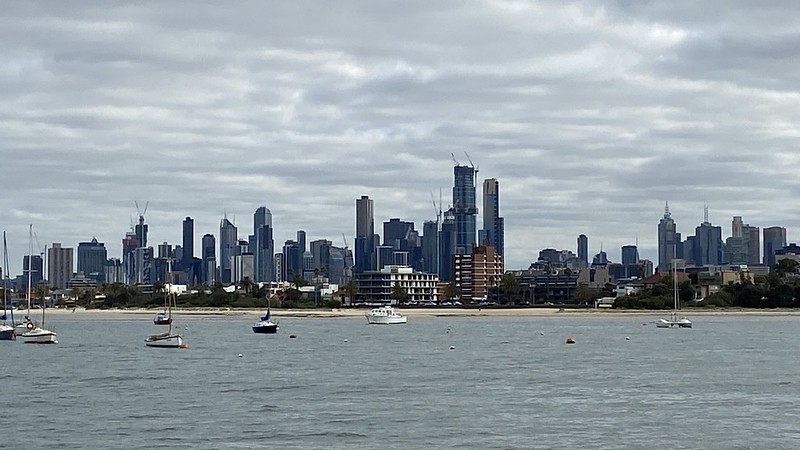
Fist stop the next (Tuesday) morning: right back to St. Kilda Beach! I wanted daytime photos of the Melbourne skyline view from there.

So! Even though Sydney is Australia's largest city (5.2 million), and the country's tallest building (though only thanks to yet another cheating spire) is technically in Gold Coast, about 524 miles up the east coast from Sydney, ever since 2006 the country's highest roof has been in Melbourne. Incidentally, although Sydney has a slightly greater number of high-rises, Melbourne's skyline has the highest average height of its buildings, giving it the skyline with the greatest visual impact in the country. And, for 13 years, Melbourne's Eureka Tower, pictured here, was both the city's highest building and the country's highest roof—with an architectural height of 975 feet, a total of 91 floors, and an observatory at 935 feet on the 88th floor. That's actually around 70 feet higher than Sydney Tower's observatory, and is actually the highest observatory in Australia (and the Southern Hemisphere). You can bet that was highest on my lists of sights to see here!
There's actually another building currently under construction in Melbourne, rather close to Eureka Tower, called Australia 108, already topped out in 2019 at 1,039 feet with 100 floors—but, it's still not open, and I don't know if there will be an observatory when it does open anyway.

View of the Yarra River where it curves to the southeast, from the 88th-floor Eureka Tower Skydeck.

Shobhit did not do this because it would have freaked him out too much, but I spent the $12 upcharge on the ticket price to experience "The Edge," which is a glass box that literally extends out from the side of the building on Eureka Tower's 88th floor. When I first learned about this, I assumed it was the same kind of thing as the static glass boxes that stick out from the observatory level of Chicago's Willis Tower (formerly known as the Sears Tower), which I walked out into
in 2016. I only learned as soon as I walked into it that this one mechanically extends, before its clouded-over windows clear up so you can see out in all directions, including straight down. Shobhit took a video of the box retracting back into the building—they wouldn't let people take cameras out into it, so I handed him my phone.
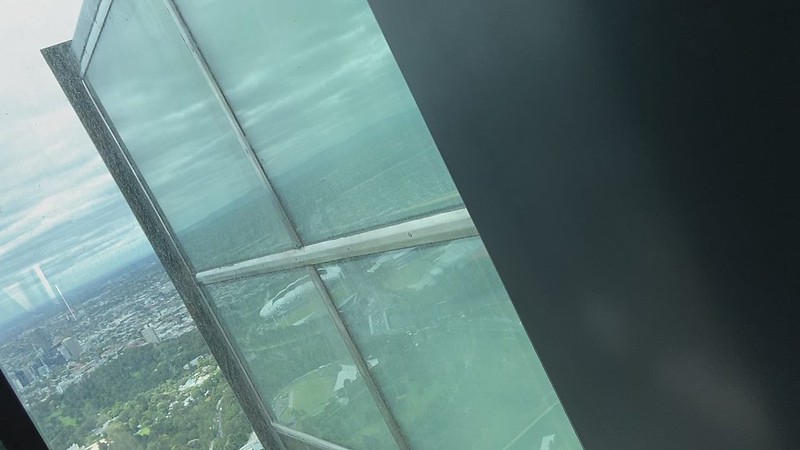
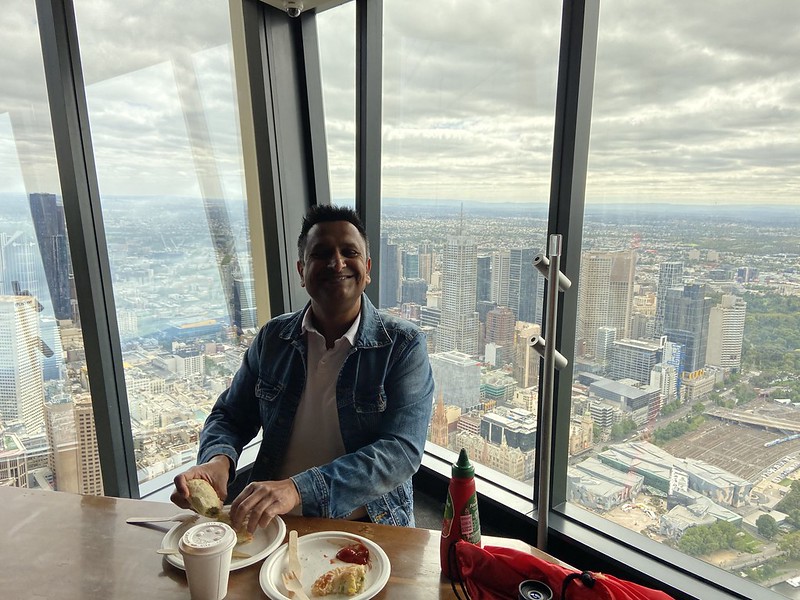
We still hadn't decided on a brunch place yet, and when we discovered a little café at the Eureka Tower's Skydeck sold desserts and savory "pasties," we therefore killed two birds with one stone.
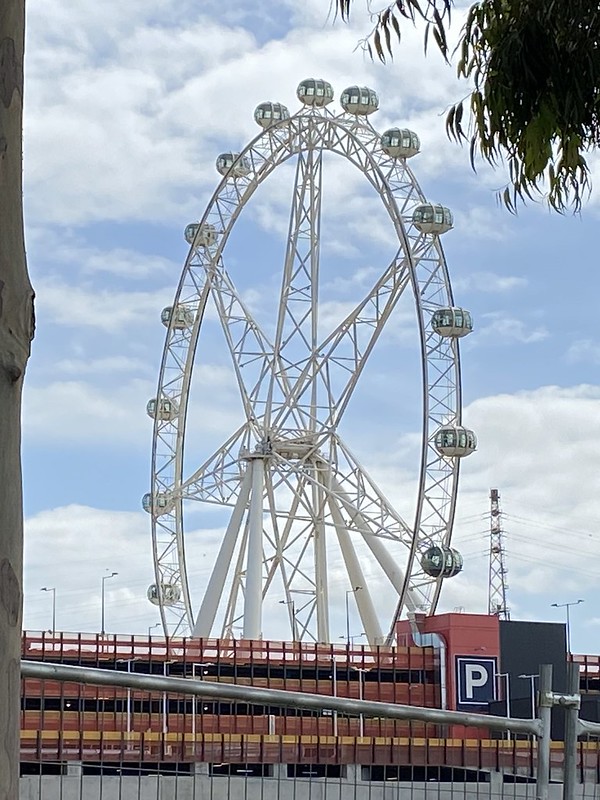
Our next tourist attraction: Melbourne's 394-ft-high "Melbourne Star," the "tallest observation wheel in the Southern Hemisphere."
It’s the 8th-tallest in the world, but I’ve noticed Australian tourist attractions love to lay claim to “Southern Hemisphere” records—which are not so hard to break when the Southern Hemisphere contains all of 20% of the world’s land and 10% of the world’s population but whatever! An observation wheel roughly the height of a 33-story building is still pretty impressive.
(For comparison: Las Vegas’s High Roller, the world’s tallest until one in Dubai overtakes it this year, is 550 feet tall. The “Seattle Great Wheel” is 175 feet.)
We actually walked the roughly two miles here from Eureka Tower, strolling through the massive Queen Victoria Market—the largest outdoor market, of course, in the Southern Hemisphere!—along the way. We met a guy at a cheese shop who was local and felt that Melbourne is a much better city than Sydney: "Melbourne just has so much more soul," he said, expressing slight displeasure in the "tourist attractions" that have dominated our much briefer visit to Melbourne. Well, this is the stuff I'm interested in! And Shobhit and I both definitely liked Sydney a lot more, both for its beaches and its far more clearly defined queer community. I still really enjoyed Melbourne too, though.

Selfie with Shobhit on the Melbourne Star, halfway through our single 30-minute revolution, reaching the peak height and with the skyline in the background.
Wednesday, March 4, 2020

Shobhit stands out on the third-floor balcony of our room at the Tolarno Hotel in St. Kilda, about three and a half miles from the Central Business District.


I did not realize until the last morning we were in Melbourne, virtually across the street from our hotel, a side street still features the fading lines of having been painted the colors of the rainbow. Turns out Melbourne had its own (much smaller) Pride Parade in early February—right down Fitzroy Street in St. Kilda, passing in front of our hotel.

We opted to save on the $20.50 per person we would have paid for the “SkyBus” one-hour express bus ride from St. Kilda to the airport, a service most people in Melbourne apparently use to get to the airport. Instead we rode for two hours on local transit, on a tram, then a train, and then a city bus—and that only cost the $4.50 (AUD) we each still had left on our “MyKi” transit cards.
The middle leg, on the local train, left from this building, Flinders Street Station, an incredibly long and narrow structure first built in 1854, the first railway station in any Australian city, and for a time as of 1926 the busiest passenger station in the world, surpassing even New York’s Grand Central Station. The current version of the building was finished in the 1910s, and it is still the busiest station in Melbourne.
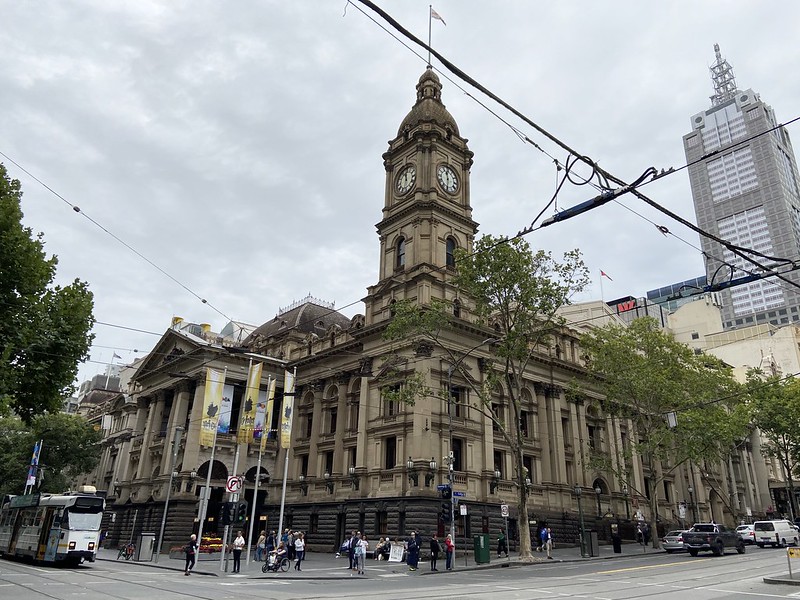
And last but not least! Here we have Melbourne Town Hall, constructed 1867—22 years earlier than Sydney Town Hall, which you saw in my first email about Sydney. I do love the prevalence of Victorian architecture here, and after seeing Sydney’s Town Hall I went out of my way to find the one in Melbourne.
[
All Melbourne photo albums on Flickr here; all overall Australia 2020 photo albums here.]























